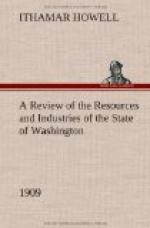Pierce county is fast becoming a network of transcontinental railroads centering in Tacoma, which, coupled with the steamboat traffic on the Sound, gives the county splendid traffic facilities. Pierce county [Page 75] for years was a non-competitive railroad point, the Northern Pacific being the only road to enter its vast fields of wealth. Within the last two years, however, the Chicago, Milwaukee & St. Paul, the Union Pacific system, and the Great Northern, realizing the wealth of the county and the importance of Tacoma as a manufacturing center, the value of her perfect harbor for shipping, the vastness of her great stretch of level tidelands for factory sites and terminal yards, and the low cost at which freight can be transferred from the rails to the sails or vice versa, have entered the field and are now spending $11,000,000 on construction and terminal work in the city of Tacoma. The addition of these new roads means a wonderful impetus to the trade of Tacoma. The Tacoma Eastern railroad, a beautiful scenic route, beginning at Tacoma, runs in a southeasterly direction through a wonderfully fertile country and vast forests of splendid timber, to Rainier National Park and Mount Rainier (Mt. Tacoma). Several trolley lines are in operation, reaching all the near-by towns and connecting Tacoma and Seattle.
In addition to these lines, many steamboats and crafts of all kinds, plying the waters of Puget Sound and the Pacific ocean, find abundant wharfage and anchorage in the harbor of Tacoma. The products of the world in large quantities pass through Tacoma in process of distribution. A constant stream of small crafts, running about the waters of the county, accommodate the local traffic.
Cities and towns.
Tacoma, with a population of about 125,000, is the county seat of Pierce county, and situated on Commencement bay. Its harbor, one of the finest in the world, and its railroad terminals, unexcelled on the Pacific Coast, as already indicated, are the center of a vast commerce by rail and water. At its door is an immense amount of water power, already developed, driving her street cars and the machinery in many of her factories. Coal and coke are in abundance within a few miles of the city, the coal being used extensively for steam and conveyed from the trains to the boats by immense electric bunkers. The coke is largely utilized in the largest lead and copper reduction plant on the coast. The great Guggenheim smelter at Tacoma reduces and turns out annually lead, copper, gold and silver worth about $10,000,000. Along her wharves are immense elevators, grain warehouses and flouring mills. Tacoma yearly ships out more grain than any other city on Puget sound. In and around the city are large saw and shingle mills, which last year cut 527,604,000 feet of lumber and 434,000,000 Shingles. Her factories and shops have $24,000,000 invested and employ 11,800 wage-earners, and her large flour mills ship their products to all parts of the world. Her packing-house products amounted to $5,000,000 in 1908. The largest car shops west of the Mississippi are located here. Her downtown streets are lined by large business blocks; she has 185 miles of street and suburban railway, and over 75 miles of paved streets.




